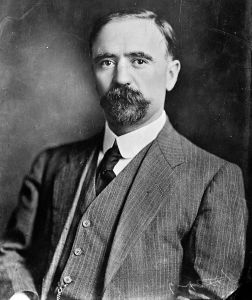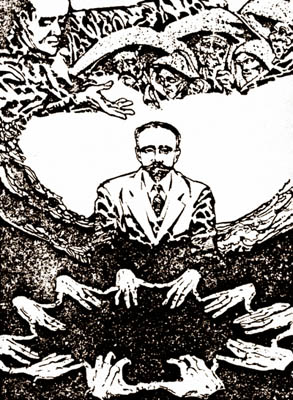
Francisco I. Madero
It is an inconvenient truth for Mexican historians that the “Father of the Revolution” Francisco I. Madero, kept in regular contact with spirits of the dead.
Yet Madero, who served as president from 1911 until his assassination less than two years later, was a deeply committed spiritist and believed he spoke to departed relatives and possibly even former Mexican leaders. Through his practice of mechanical writing, Madero put pen to paper and let invisible beings guide his hand, shakily transcribing words of wisdom from beyond the grave.
With a “Metaphysical Odyssey into the Mexican Revolution,” U.S. novelist and translator C.M. Mayo has written one of the only books to focus on this key aspect of his life.
Featuring the first English translation of his secret work, the “Spiritist Manual,” the book presents Madero’s overview of his own guiding beliefs.
Mayo’s fascinating introduction spreads to 150 pages, with an index that includes everyone from Abraham Lincoln to Oprah Winfrey, Joseph Smith to Mohandas Gandhi.
The author discovered the “Spiritist Manual,” written by “Bhima,” while scouring the archives of Mexico’s National Palace. While Madero’s archive is open to the public, Mayo was privileged with a private viewing owing to the invitation of her husband, then Finance Minister Agustin Carstens. When the curator told her that “Bhima” was Madero himself, the author “immediately recognized” that this was “a fundamental document for understanding the personal philosophy of the leader of Mexico’s 1910 Revolution.”
Madero’s complex belief system still has implications today. A businessman from Coahuila, he rejected a stolen election to take up arms against the dictatorship which had ruled for 35 years.
As Mayo explains, without his “daring and passion” the “Revolution might not have begun when it did,” and modern Mexico “might not have been able to rightly call itself a republic.”
Madero is celebrated as Mexico’s “Apostle of Democracy,” because after his successful coup, he refused to make himself president; instead choosing to campaign to become democratically elected leader.
“His commitment to democracy and the law have stood as an inspiring example for generations of Mexicans,” Mayo tells the Mexican Labyrinth. “Indeed, his remains are enshrined in Mexico’s Monument to the Revolution.”
 Madero’s belief in spirits, far from being separate from his political career, was a driving force behind it. Following the doctrine formulated by French educator Allan Kardec in the 1850’s, the revolutionary believed that the dead could be contacted in a variety of ways, whether through séances, trances or mechanical writing. In this way, he sought counsel at crucial moments of his campaign, communicating with his dead brother or even, it is believed, former president Benito Juarez.
Madero’s belief in spirits, far from being separate from his political career, was a driving force behind it. Following the doctrine formulated by French educator Allan Kardec in the 1850’s, the revolutionary believed that the dead could be contacted in a variety of ways, whether through séances, trances or mechanical writing. In this way, he sought counsel at crucial moments of his campaign, communicating with his dead brother or even, it is believed, former president Benito Juarez.
Yet despite his idealism, Madero carefully concealed his beliefs from the public. He wrote under a pseudonym and asked for discretion from his peers. In Mayo’s words, he liked to remain “coyly, and sometimes very lumpily behind the curtains.”
Likewise, in the decades following his death, Mexican politicians steered clear of mentioning this aspect of his life. In Catholic Mexico, public discussion of the topic was taboo, even as Spiritism, witchcraft and occultism were practiced in secret by many government figures.
For Mayo, references to Madero that exclude his beliefs are not just flawed but misleading. When a “surgically enhanced story is told and retold without question it becomes a kind of lie,” she warns.
As his manual makes clear, Madero’s concern with spirituality informed his every action. Apart from “mechanically writing” the advice of the dead, he practiced hypnotism, meditation and magnetic therapy. His philosophy encouraged a strictly regulated lifestyle, and he was a teetotal vegetarian who kept to a rigorous schedule.
“The man who is sober, temperate, generous to his fellows and of pure heart, is most likely to receive inspiration from higher spirits,” he notes in his manual.
Madero’s philosophical outlook may also have emboldened him politically. As a believer in reincarnation, his earthly actions were set to have implications beyond the here and now.
“Madero’s Spiritism prompted him to think of his actions as having both support in the invisible world and an impact on himself and others beyond the material plane, and beyond his lifetime,” Mayo says. “This enabled him, I believe, to strategize and act in ways most men in his position would never dare to even contemplate.”
Madero’s manual shows a clear concern with martyrdom. “We must always be ready to sacrifice ourselves for the common good,” he writes. “In this way imitating the example of Jesus and so many martyrs and heroes who have shed their blood for humanity.”

General Victoriano Huerta
Sadly, for Mexico, his words proved prophetic. In 1913, rebels marched on Mexico City and the president accepted protection from General Victoriano Huerta, only to be betrayed, arrested and shot. He was succeeded by Pedro Lascurain, who held power for all of 45 minutes, before Huerta decided he wanted power himself.
Even in his downfall, Spiritism was a factor. In the tense political climate of the age, Madero’s enemies looked for anything to smear him, and his spiritual beliefs provided perfect ammunition.
“In an attempt to discredit President Madero, his political enemies published some of the ‘Spiritist Manual’” Mayo says. “Many newspaper cartoons pictured him as a medium communing with ghosts and/or tipping tables; and after taking Madero prisoner in the coup d’etat, General Victoriano Huerta wrote to US Ambassador Wilson asking if he thought he should send Madero to the lunatic asylum.”
What’s more, we know that U.S. Ambassador Henry Lane Wilson, who was instrumental in Madero’s fall, was deeply suspicious of his Spiritism. In his memoirs, Wilson says Madero suffered from a “dangerous form of lunacy.”
Having faced such hostility in his lifetime, Madero would no doubt have delighted in the publication of his translated “Spritist Manual” more than a century on. Mayo’s introduction is itself an invitation for his philosophy to be brought center stage.
She asks her readers to “simply acknowledge that Madero was a spiritist, to understand what that means,” and “why and how it informed what he did and did not do.”
She also invites consideration of “how some friends and some enemies saw him – as leader of the 1910 revolution and as president of Mexico, in that comet-like moment when, with a heart full of love, he blazed into Mexican history and so profoundly changed it.”
Twitter: @Stephentwoodman
